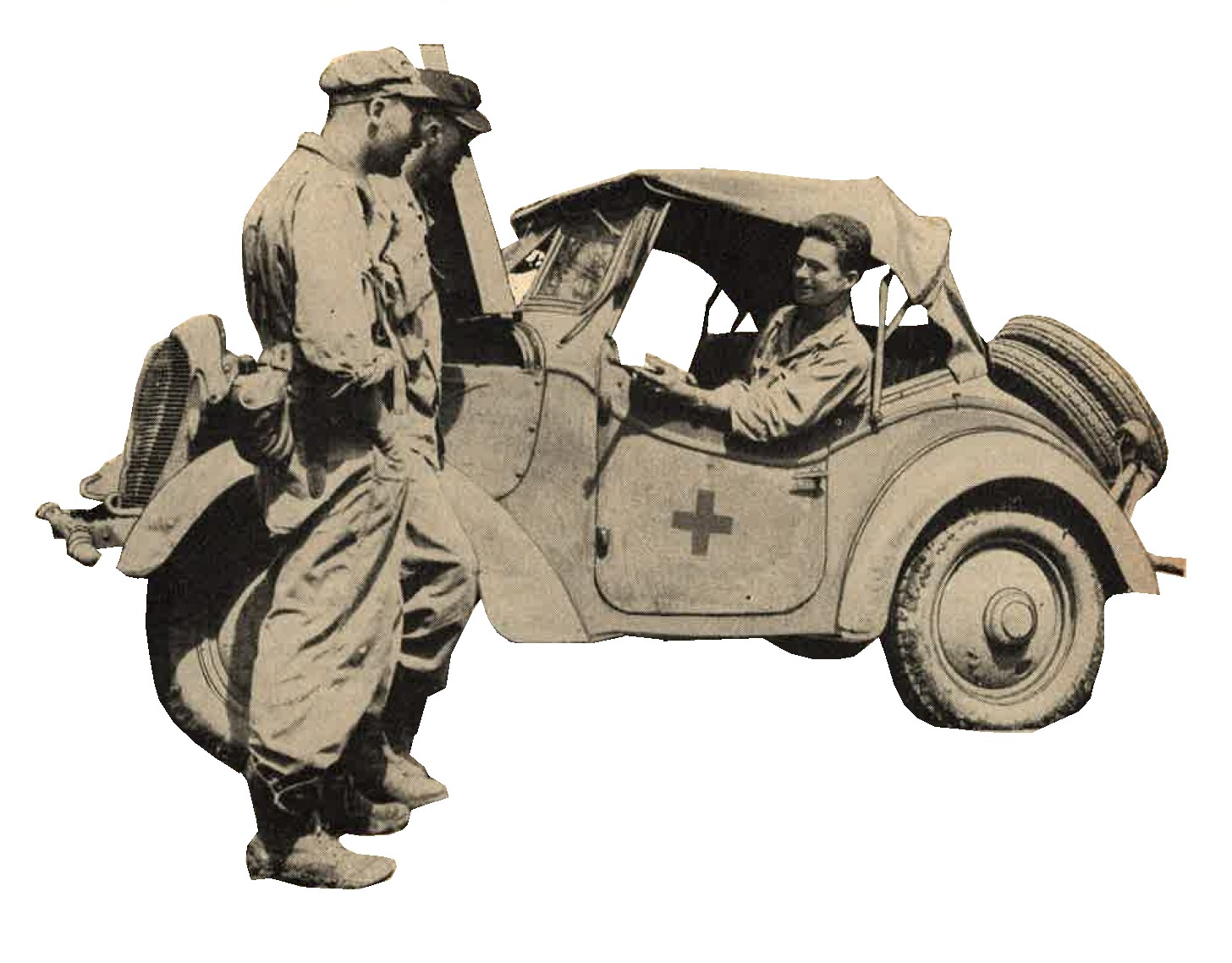CHAPTER 9-D2 EQUIPMENT

SECTION VII - WWII JAPANESE MILITARY AUTOMOTIVE AND LAND TRANSPORT EQUIPMENT.
1. GENERAL
a. Although the automotive manufacturing industry was comparatively new in Japan, considerable progress had been made by the end of 1941. Both Ford and General Motors had maintained large assembly plants in Japan proper for many years, and very large numbers of the trucks produced by these plants naturally are used now by the Japanese Army. In addition, very large numbers of European and American motor vehicles were captured by the Japanese in their advance southward.
b. All motor vehicles manufactured in Japan are right-hand drive. They have comparatively high ground clearance and small turning radii. The Diesel is the preferred power unit for heavy vehicles, and many are so fitted. Power weight ratios generally are not good, and tires often are overloaded.
Power take-off systems of various kinds often are found. Hydraulic foot brakes were not installed until recent years; many vehicles still are equipped with mechanical brakes. Because of local regulations, the emergency, or handbrake, is always entirely separate from the main braking system and is mechanically actuated.
c. Because of gasoline shortages, charcoal and wood gas producers began to be installed in 1937. by 1942, all non-military vehicles had been converted to their use, and it seems probable that many military vehicles now operating in Japan proper are using self generating fuel systems.
2. WWII JAPANESE MILITARY PASSENGER CARS
a. Japanese model 95 (1935) 4 x 4 scout car. This lightweight, unarmed, reconnaissance vehicle (Figure 394) was developed after the Manchurian Incident, when the need for an all purpose scout car became pressing. Its air cooled engine offers many advantages for operations in Manchuria and North China, where very low temperatures often are experienced. Initial difficulties with the four wheel drive, particularly with the front universal joints, are believed to have been overcome. Special tires, with heavy rubber lugs, are provided for exceptionally difficult terrain.
Engine:
|
Chassis:
|
b. WWII Japanese Standard Nissan 5 passenger sedan.
First produced in 1937, the Nissan (Figure 395) has had several modifications, but no major improvements.The design, and the tools to make it, were purchased from the Graham-Paige Company, which designed and tooled up for this model in 1935, but never went into production. The design is not remarkable in any way; from modern standards the power weight ratio is poor.
|
Specifications:
General:
|
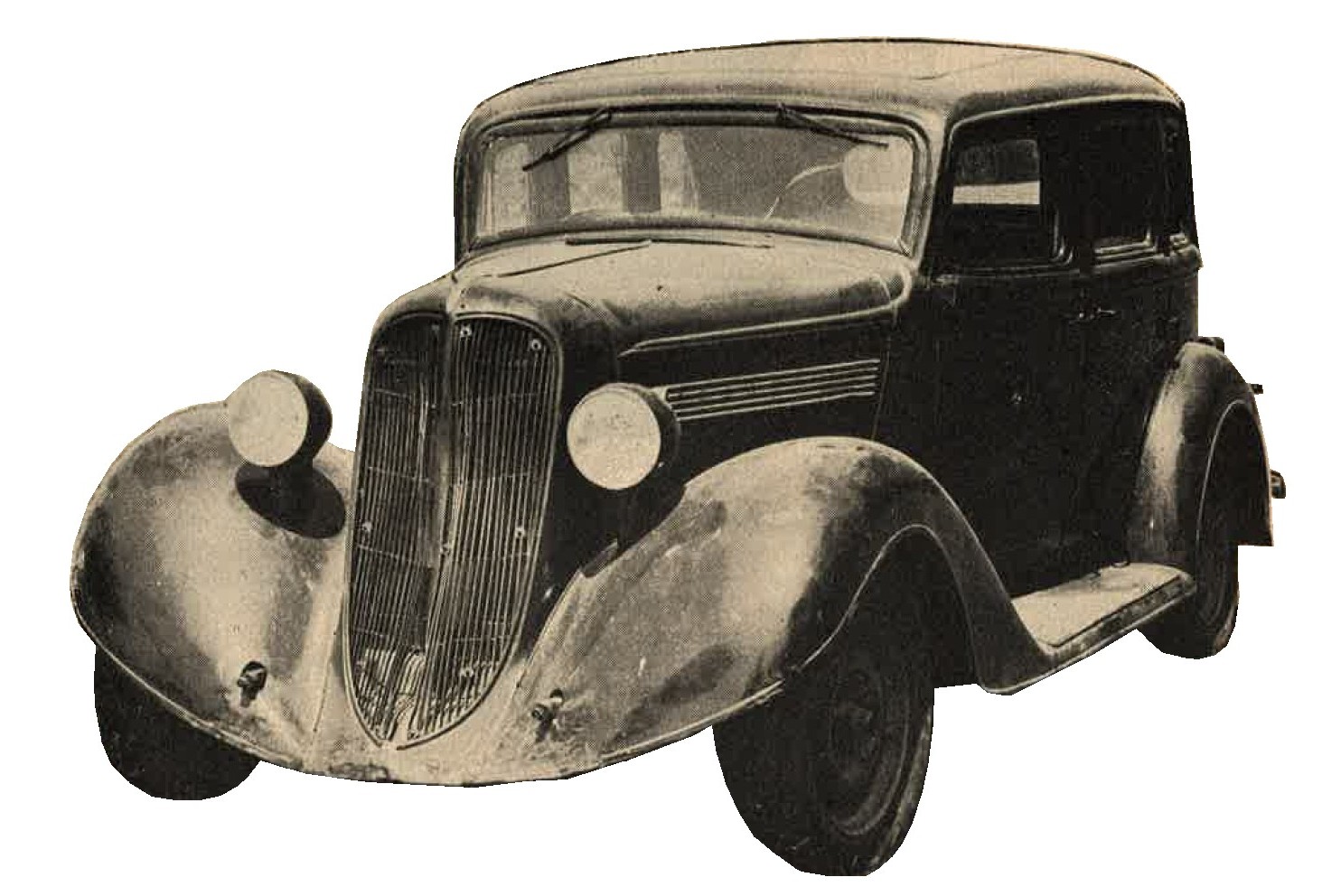
Figure 395. Standard Nissan 5-passenger Sedan. |
Engine:
|
Chassis:
|
c. WWII Japanese military Model 93 (1933) Staff car.
This 6-wheeled staff car (Figure 396) was developed over a period of years. Originally, Hudson and Studabaker chassis were used, but a Japanese chassis ultimately was developed. Available specifications indicate a poor power weight ratio, and a performance not comparable with that of any U.S. command car. However, this vehicle has not yet been reported from the field, and improved models may exist.
|
Specifications:
General:
|
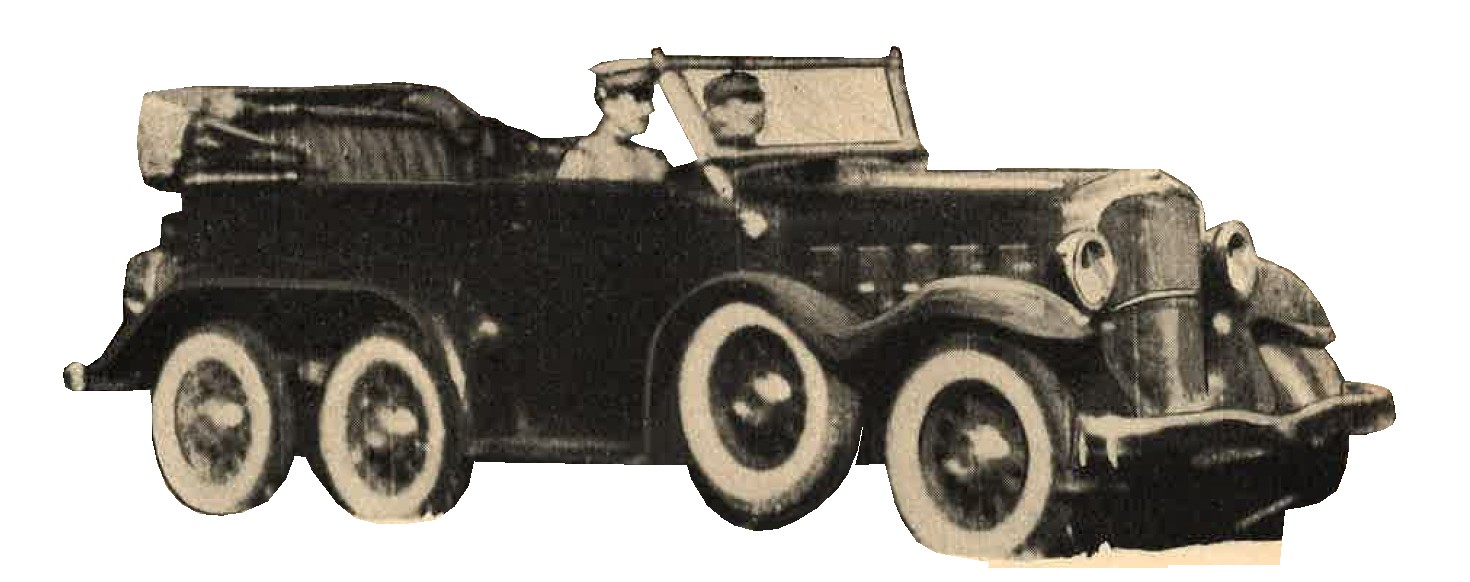
Figure 396. Model 93 (1933) staff car. |
Engine:
|
Chassis:
|
3. WWII JAPANESE MILITARY TRUCKS.
a. WWII Japanese army Model 94 (1934) 6 x 4 truck..
The development of this chassis (Figure 397), in which the rear 4 wheel drive and 2 front wheels only steer, has been progressing for more than 15 years. In recent years an attempt has been made to distribute this vehicle to commercial users, and prior to 1941 a substantial subsidy was paid to private purchasers. Initial difficulties with the final drive now have been overcome, and the vehicle is reliable, although the power-weight ratio is not good. Ground clearance is unusually high and one or more auxiliary transmissions can be fitted. more powerful Diesel engines than those mentioned in the specifications now may be in use. The chassis of the Model 94 is the basic one for the Japanese Army's armored car.
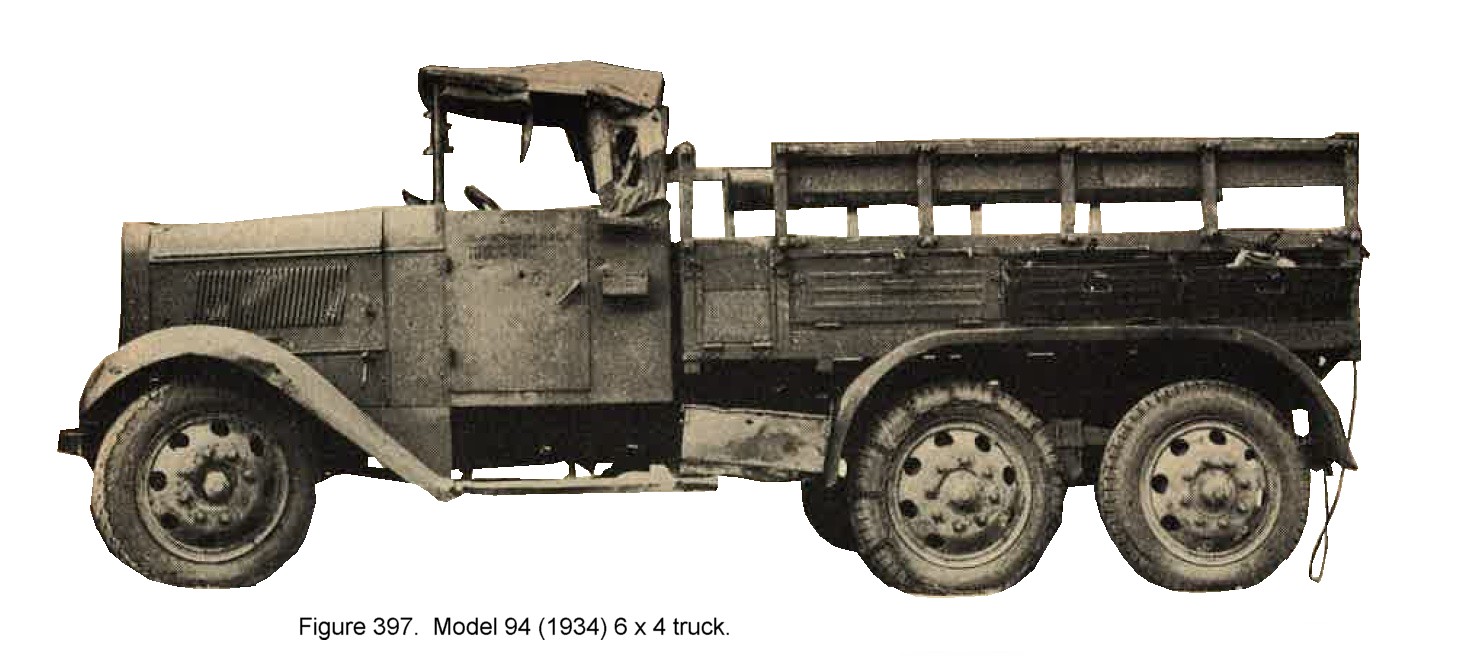
Specifications:
| GENERAL | TYPE A (Gasoline) | TYPE B (Diesel) | |||
| 1. | Weight | --------- | 7,500 pounds | --------- | 8,1870 pounds. |
| 2. | Length | --------- | 17 feet 8 inches. | --------- | 17 feet 8 inches. |
| 3. | Width | --------- | 6 feet 2 inches. | --------- | 6 feet 2 inches. |
| 4. | Height | --------- | 7 feet 4 inches. | --------- | 7 feet 4 inches. |
| 5. | Wheelbase | --------- | 9 feet 2 inches. | --------- | 9 feet 2 inches. |
| 6. | Clearance | --------- | 11 inches. | --------- | 11 inches. |
| 7. | Tread | --------- | 4 feet 11 inches. | --------- | 4 feet 11 inches. |
| GENERAL | TYPE A (Gasoline) | TYPE B (Diesel) | |||
| 1. | Type | --------- | Gasoline, 6 cylinder "L" head (side valve). | --------- | Diesel 4 cylinder. |
| 2. | Horsepower | --------- | 68 maximum. | --------- | 70 maximum. |
| 3. | Bore | --------- | 90-mm (3.54 inches). | --------- | 105-mm (4.13 inches. |
| 4. | Stroke | --------- | 115-mm (4.53). | --------- | 140-mm (5.51 inches). |
| 5. | Displacement | --------- | 4,390 cc (268 cubic inches). | --------- | 4,850 cc (296 cubic inches). |
| 6. | Compression ratio | --------- | 5.25 to 1. | --------- | 17 to 1. |
| 7. | Electrical system | --------- | 12 volts. | --------- | 12 volts. |
| GENERAL | TYPE A (Gasoline) | TYPE B (Diesel) | |||
| 1. | Final drive reduction | --------- | 8.33 to 1. | --------- | 6.75 to 1. |
| 2. | Transmission | --------- | Standard, 4 forward, 1 reverse. | --------- | Standard, 4 forward, 1 reverse. |
| 3. | Brake | ||||
| Foot: | --------- | Mechanical, expanding | --------- | Mechanical, expanding | |
| Hand: | --------- | Mechanical, contracting | --------- | Mechanical, contracting |
b. WWII Japanese Model 97 (1937) Nissan 4 x 2 cab-over engine truck.
The original model, produced in 1937, was a combination of Graham Paige and Japanese designs. The cab-over engine design was adopted because of the narrowness of Japanese roads. The whole front axle assembly proved to be too light, howevwe, and great difficulty was encountered in maintaining the alignment of the front wheels to prevent excessive tire wear. An improved model of more conventional design was finally developed, but a very large number of the original models still are being used by the JapaneseArmy. The power-weight ratio of the Model 97 is not good.
Specifications (104 inch wheelbase model)
General:
|
Engine:
|
Chassis:
| 1. | Final drive reduction | --------- | 6.19 to 1. |
| 2. | Transmission | --------- | Standard, 4 forward, 1 reverse. |
| 3. | Brakes | ||
| Foot | --------- | Hydraulic. | |
| Hand | --------- | Mechanical. |
c. WWII Japanese military Model 1 (1941) 4 x 2 Toyoda truck.
After disastrous experiments with a truck of their own design, the Toyoda company finally produced this model (Figure 398), almost an exact copy of the 1939 Chevrolet.
Some manufacturing difficulties have been encountered, and the present power weight ratio is not considered satisfactory.
Specifications:
General
|
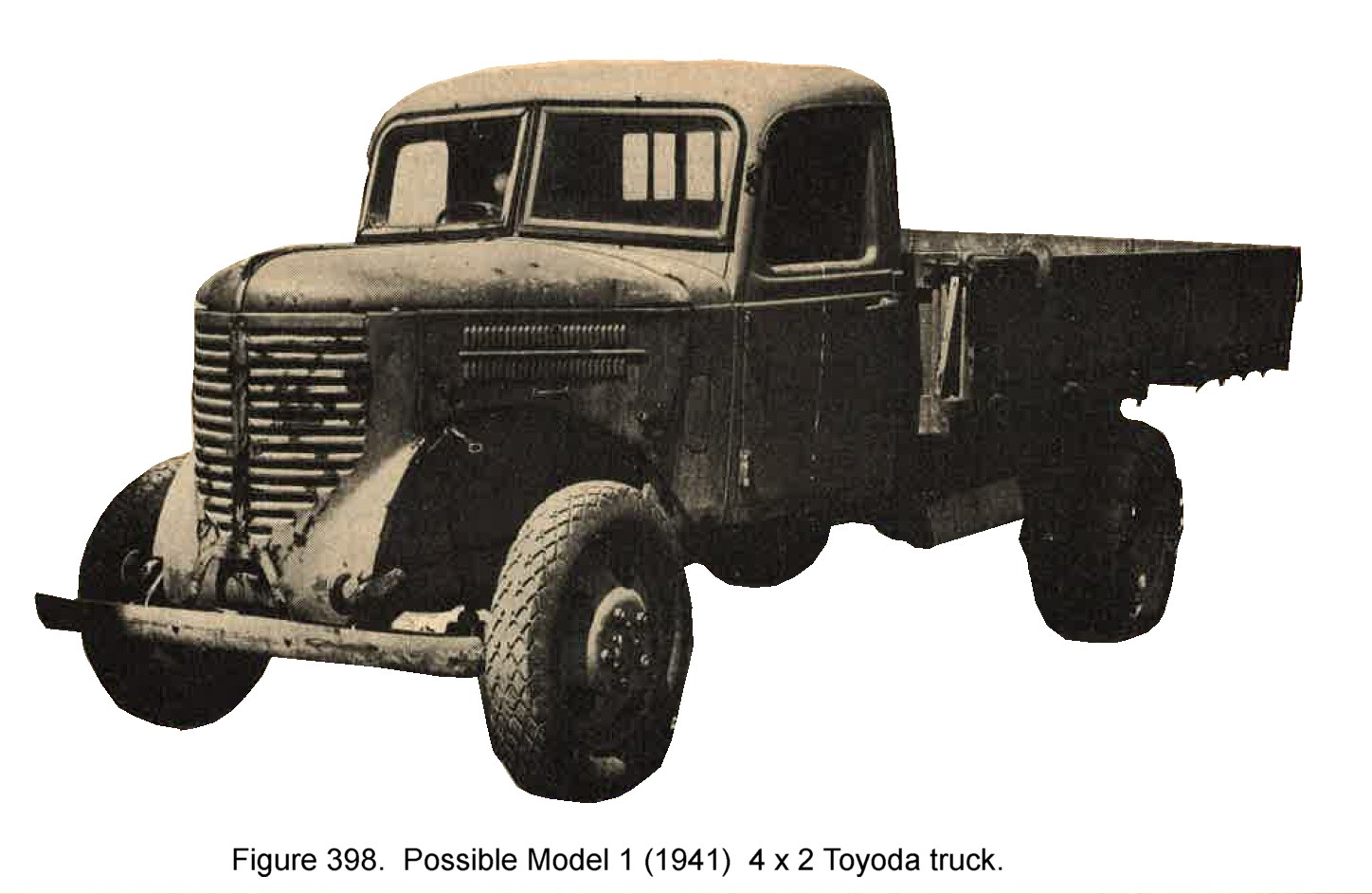 |
Engine:
|
Chassis:
|
4. WWII JAPANESE MILITARY TRAILERS.
a. WWII Japanese Model 94 (1934) 3/4/ ton tracked trailer.
This trailer (Figure 399) has been designed specially for towing behind the various model tankettes. In China it has been used extensively for transportation of supplies and ammunition. The body of the trailer appears to be of pressed steel construction, and teh suspension consists of 2 bogie wheels with front and rear idlers. Track is similar to that used on the tankette.
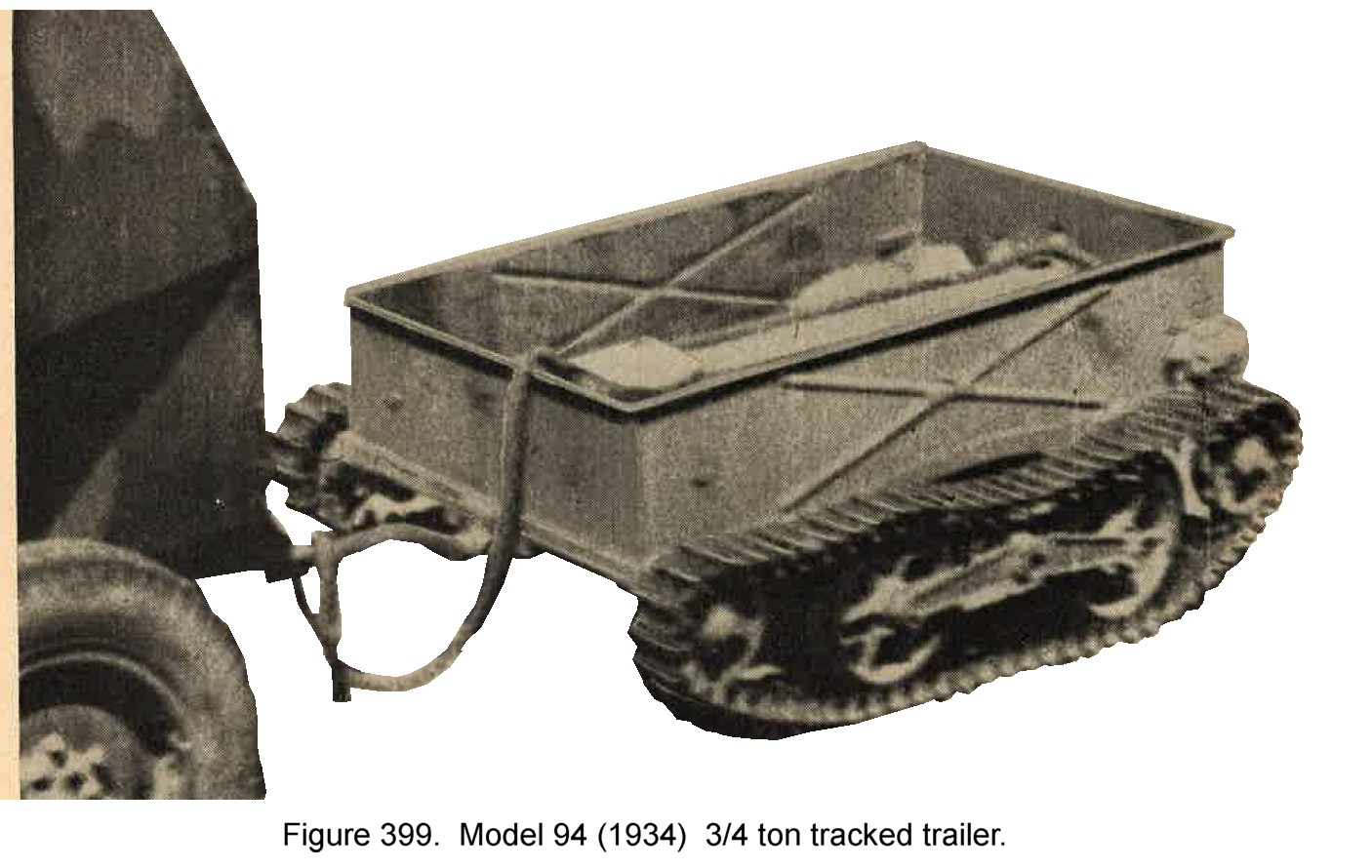
b. WWII Japanese military 2-Wheel trailer.
This 2 wheeled trailer (Figure 400) is designed specially for high speed transport. It is of metal construction and is equipped with pneumatic tires.
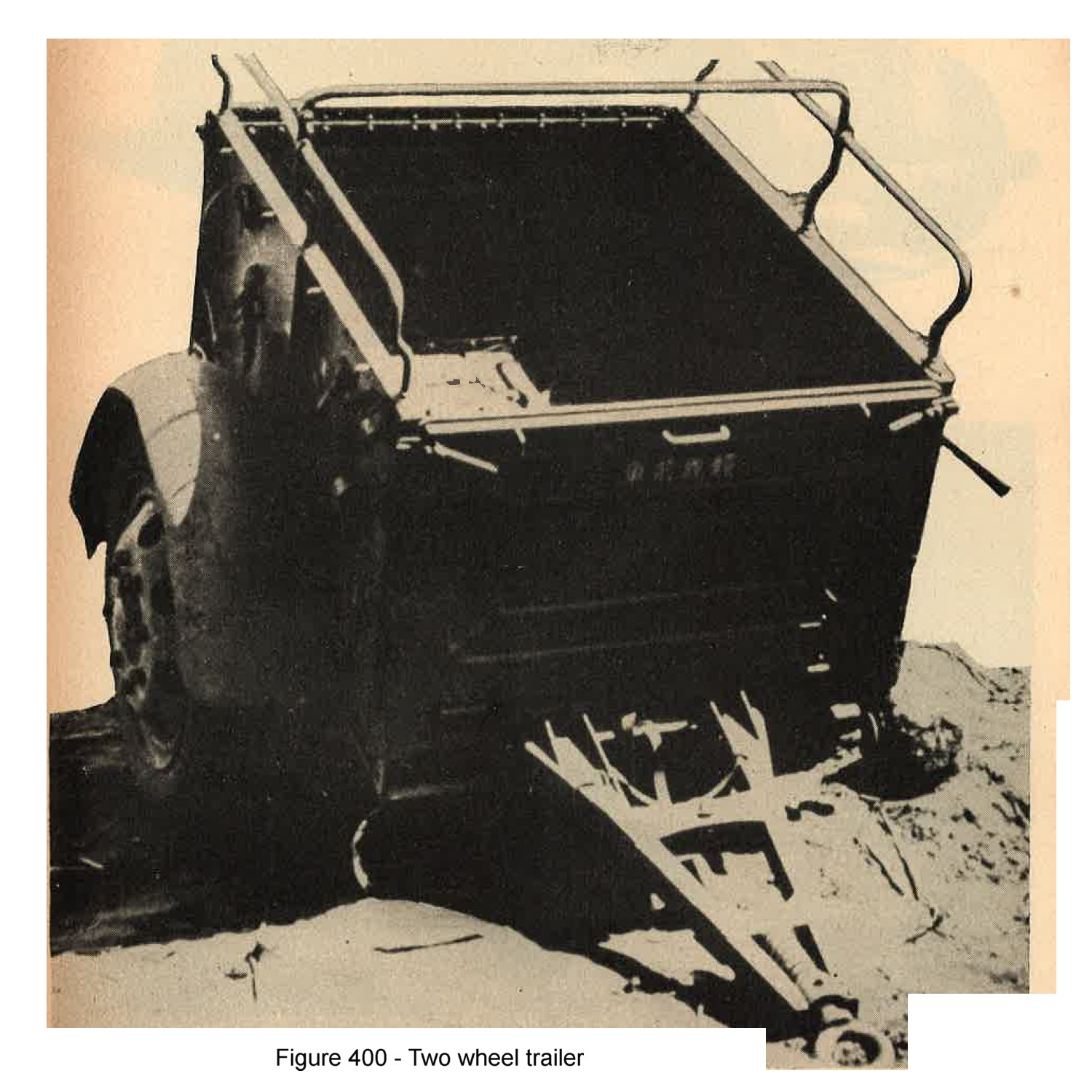
Figure 400. WWII Japanese two wheel trailer.
5. WWII JAPANESE ARMY MOTORCYCLES.
a. WWII Japanese Model 97 (1937) motorcycle.
Japanese military motorcycles (Figure 401) are adaptations of Harley davidson designs. Several models between 1,000 cc and 1,500 cc displacement, have been produced, but it is believed that Model 97 is generally in use. Extra large wheels can be fitted to obtain maximum ground clearance. The design of all types includes provision for a sidecar, which can be fitted with a light machine gun for which at least two different mounts are available. Only minor changes have been made in the original Harley Davidson designs, and peformance is generally satisfactory.
Specifications
General
|
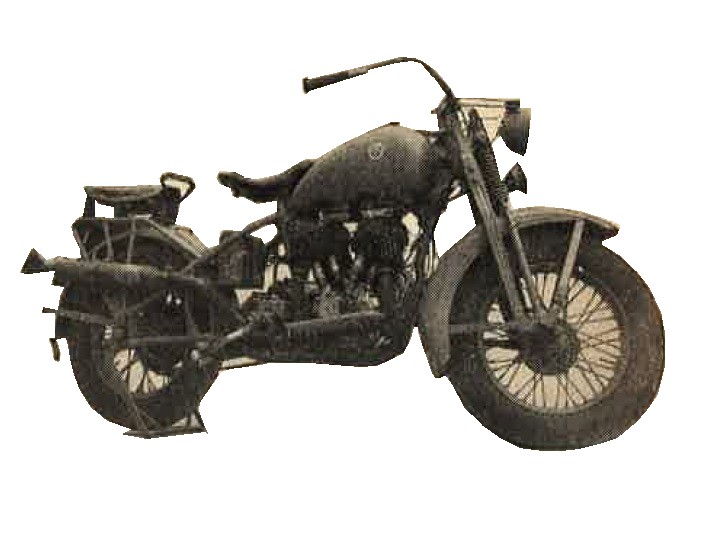
Figure 401. Model 97 (1937) motorcycle. |
Engine
|
Chassis
|
b. WWII Japanese Motor tricycles (Sanrinsha).
The motor tricycle (Figure 402) has been developed as a commercial freight carrier in Japan since 1930. Many commercial versions exist. With engines ranging from 350 cc to 1,000 cc in displacement. Lighter types have single chain drive without differentials, whereas heavuer types may have shafts or double chain drive, with differentials.
Load capacities vary from 300 to 1,000 pounds. A standard three speed transmission, and reverse, is used. It is believed the army adopted whatever types were available, and that no standard army model exists.
|
Lighter tricycles may have had 2 cycle engines, and some 2 cylinder types have been encountered. The ussual
design, however, is chain driven, with a slow speed, single cylinder, 4 cycle engine of about 750 cc
displacement.
Specifications:
|
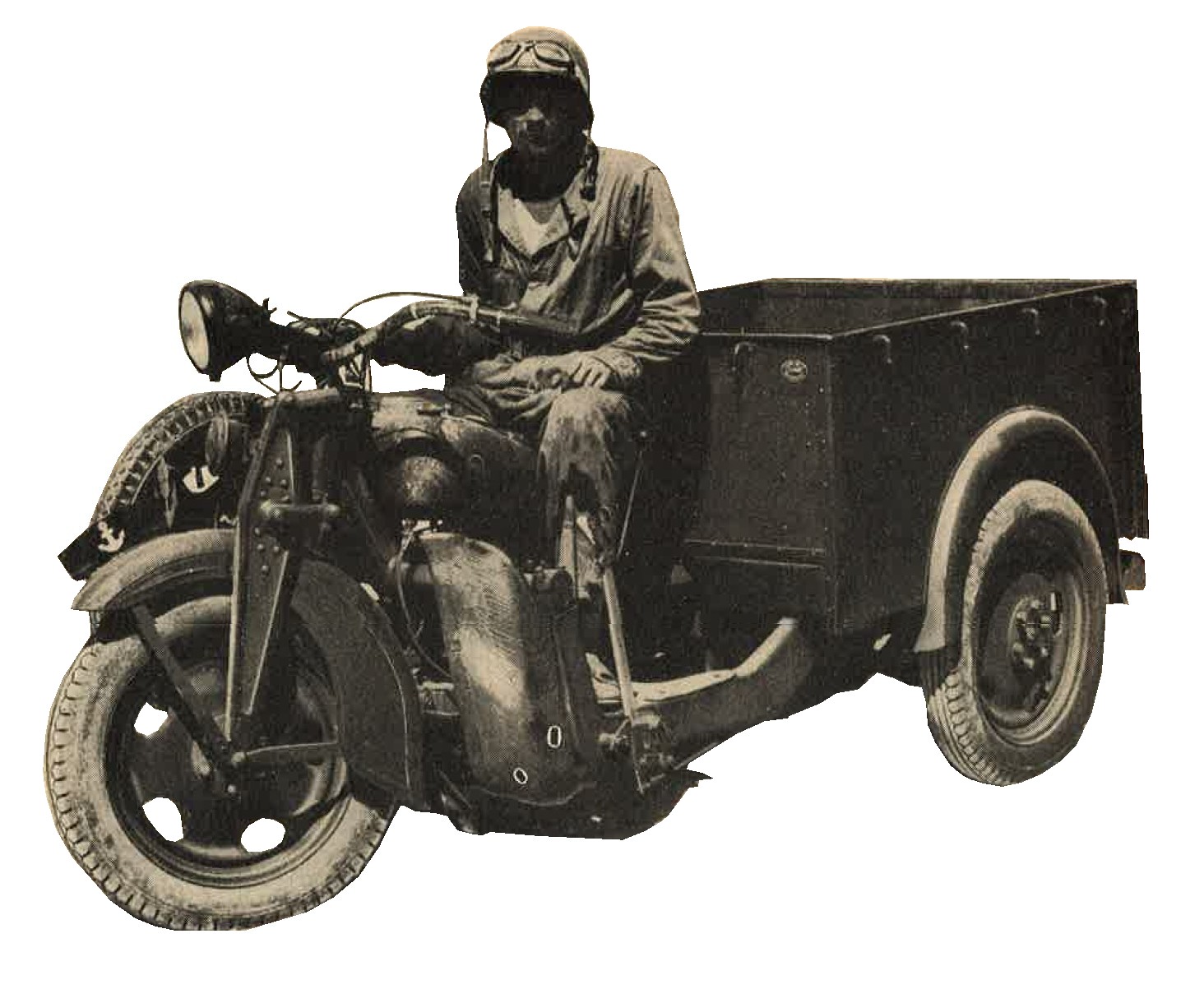
Figure 402. Motor tricycle. |
6. WWII JAPANESE MILITARY BYCICLES.
Japan is one of the world's largest producers of bicycles; in 1940 there were 1,000,000 in Tokyo alone. There is a standard army type, designed along English lines, with front and rear wheel brakes and large wheels. It has been used extensively in the present war.
7. WWII JAPANESE MILITARY TRANSPORT CARTS.
The Japanese army employs a variety of hand and horse drawn carts. Several of these are shown in figures 403, 404, 405.
|
Figure 403.
Army transport cart of wooden construction with metal bracing. Characteristics;
|
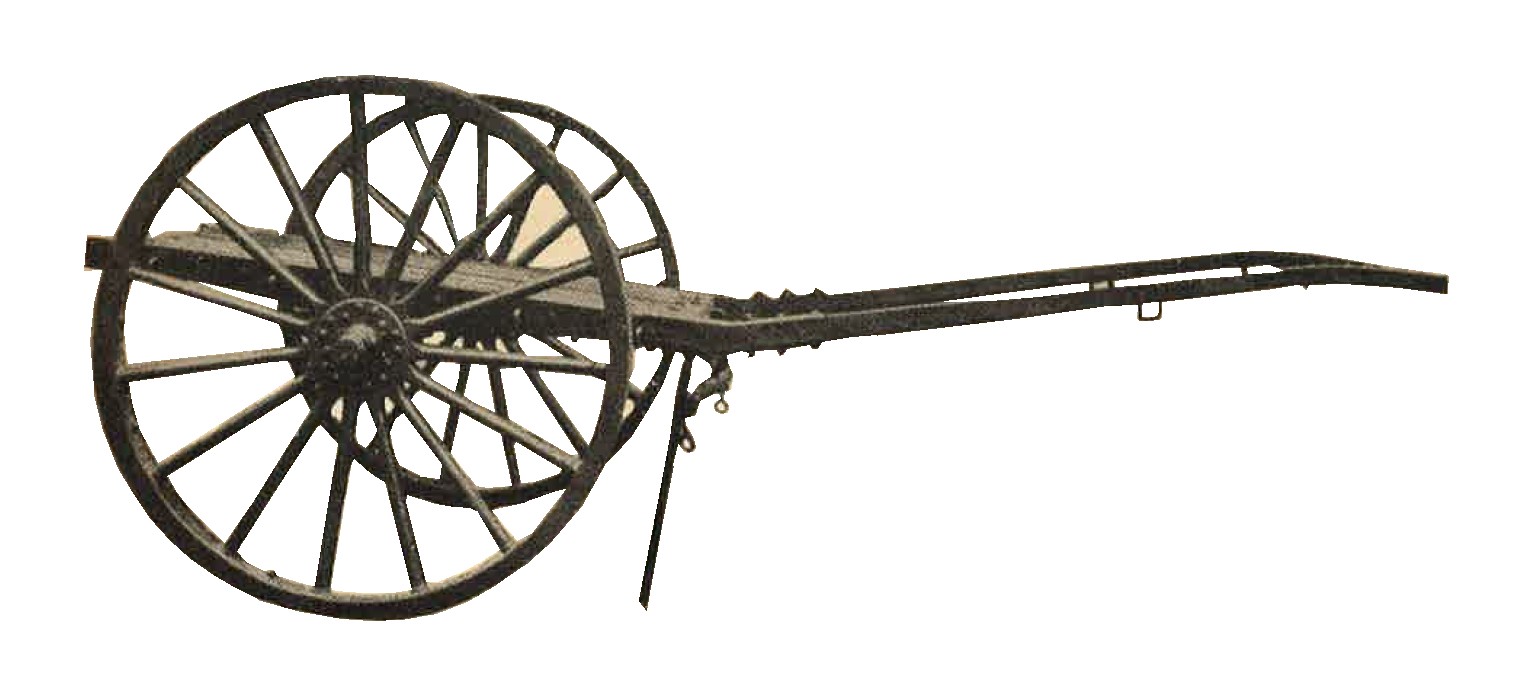
|
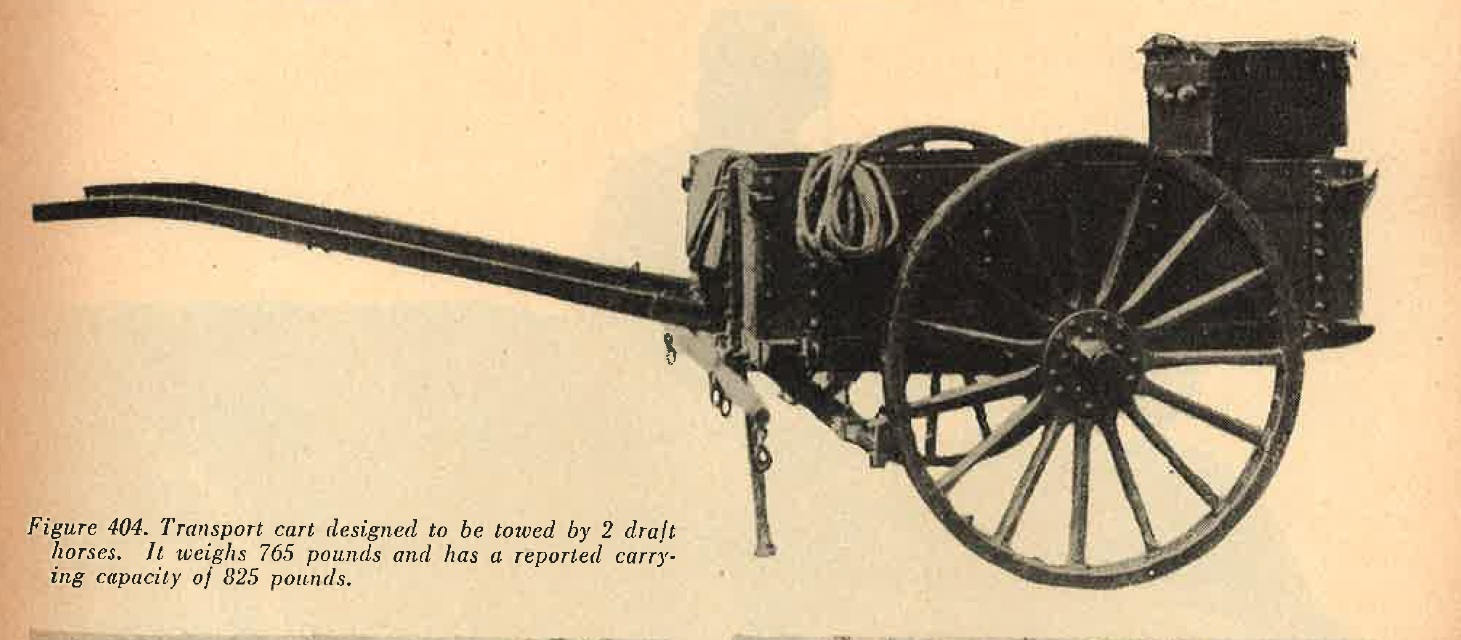
Figure 404. Transport cart designed to be towed by two draft horses. It weighs 765 pounds and has a reported carrying capacity of 825 pounds.
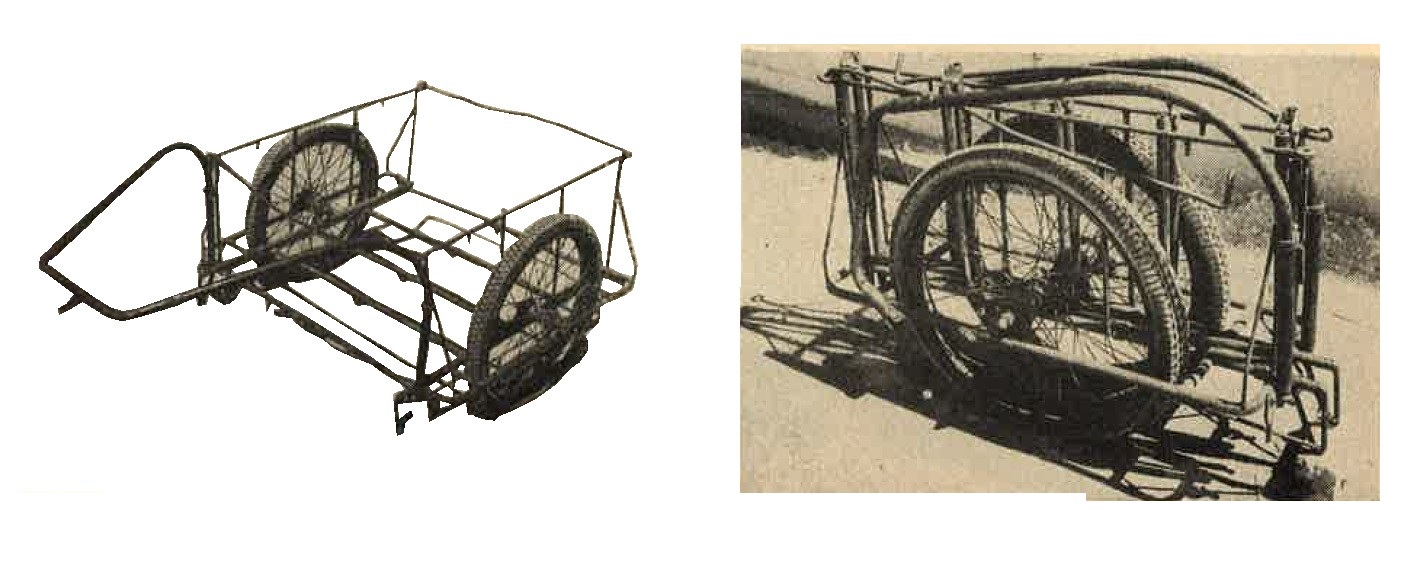
Figure 405. Collapsible hand cart of metal construction weighing 100 pounds. It may be pulled by hand or towed by bicycle.

SECTION VIII - WWII JAPANESE MILITARY TENTAGE.
1. GENERAL.
Although the Japanese excellent octagonal tents, very little use is made of tentage in training or in the field, aside from shelter halt tents. Tents are considered necessary only for medical units and field hospitals, or for troops in regions where other shelter is not available. In inhabited regions, troops are billeted in houses or other buildindgs; in jungles, native huts frequently are built as soon as the situation becomes sufficiently stabilized. The Japanese are unable to improvise shelters in cold barren regions and therefore house large numbers of men in tents. Even there, every effort is made to bring forward building materials in order to get the men from under canvas as soon as possible.
a. WWII Japanese army Octagonal tent.
The octagonal tent ordinarily houses from 15 to 20 men, although the manual states taht 40 can be accommodated in the tropics amd 36 in cold regions (Figure 406).
Pyramidal in shape, it is made of comparatively ligjhtweight, closely woven duck. It is about 24 feet in diameter and uses a 12 foot 9 inch center pole.
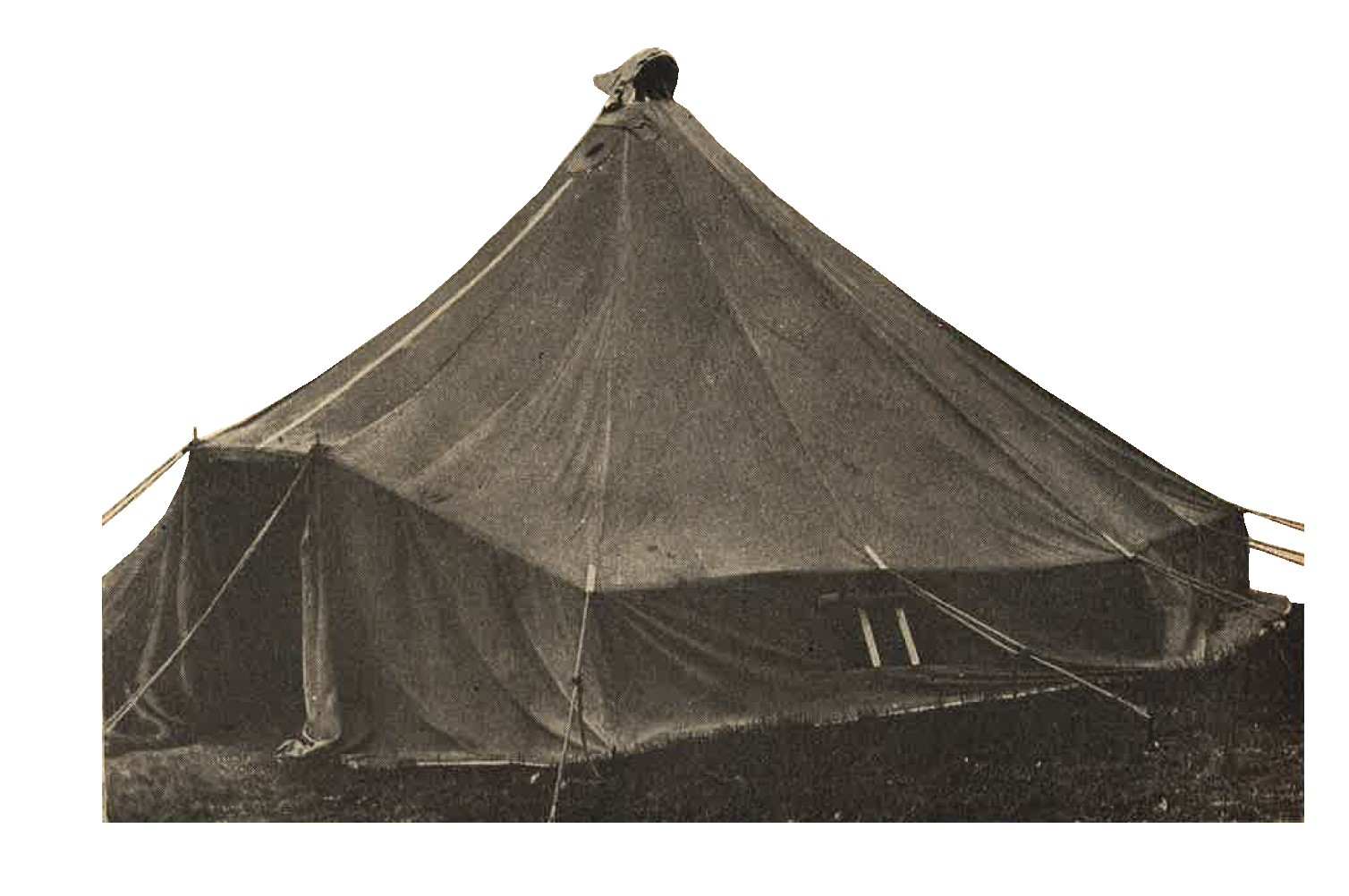
Figure 406. Japanese octagonal tent. (This complete tent weighs 118 pounds, without pegs and poles.
b. Use of the octagonal in cold climates.
(1) In cold regions a second tent of closely woven, strong, white cotton is suspended inside the main tent and held in place by tie tapes. The 6 to 8 inches of air space between the tent and tent liner gives good insulation against the cold, eliminates drafts, and provides a second shelter against moisture. Such a tent may be heated efficiently and economically because of these double walls which also permit the use of dim lights at night without danger of violation blackout discipline.
(2) Two types of stoves are used in these tents, both with grates for burning coal or charcoal. One is a drum stove, 20 to 22 inches in diameter and 24 inches high, with a 6 inch opening in the center of the top for the stovepipe. The second type of stove is cast iron, about 2 feet high, 18 inches deep, and 14 inches wide. Both types cab be broken down to save shipping space.
c. Use of the octagonal tent in the tropics.
The same tent also is used in the tropics, though to a very limited extent, because native type thatch huts usually are considered superior. A mosquito netting takes the place of the inner liner in tropical climates.

SECTION VIII - WWII JAPANESE MILITARY MEDICAL EQUIPMENT.
1. GENERAL.
Japanese military medical equipment is practical, and civilian medical practices have been considered relatively modern.
2. WWII JAPANESE MILITARY FIELD EQUIPMENT.
a. Drugs Many of the drugs dispensed have been discarded in European and American medical circles, and some preventatives examined have been found to be without effect. Very extensive use is made of drugs that have to be injected, and field kits (Figure 407) contain ampoules of a wide variety of sizes and shapes, with no standardization for shipping and packaging. Much use is made of proprietary (patent) medicines, and standard drugs such as quinine, aspirin, and iodine are of course employed. Anti malarials, besides quinine, apparently are being used in increasing quantity. Vaccines and serums are comparable with those in use in other Armies, although there are indications tehre are indications that some of them are not very effective.
Vitamin products are used extensively, in the form of powders, or tablets (both vitamin B and C) as well as in solutions for injections. Even medical kits contain such vitamin tablets.
|
b. Instruments.
A very great variety of instruments are in use. Most of these appear to be only fair in quality, of nickel plated carbon steel instead of stainless steel. The case shown in Figure 408 is heavy, lined with nickel plated copper, and equipped with aluminum instrument racks. The tray can be removed with the instruments in it and used as a sterilizer - a very convenient feature. Blood transfusion kits examined are bulky and fragile, usable only with a system of transfusion discarded some years ago by other armies. No evidence of the use of blood plasma has been found. |
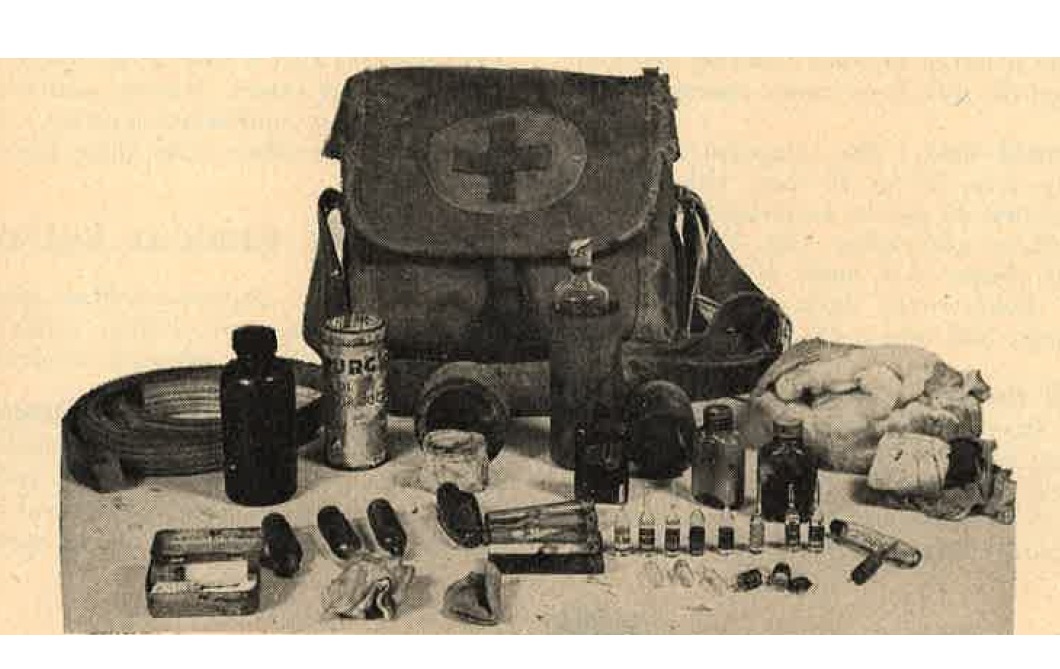
Figure 407. First aid kit and contents. |
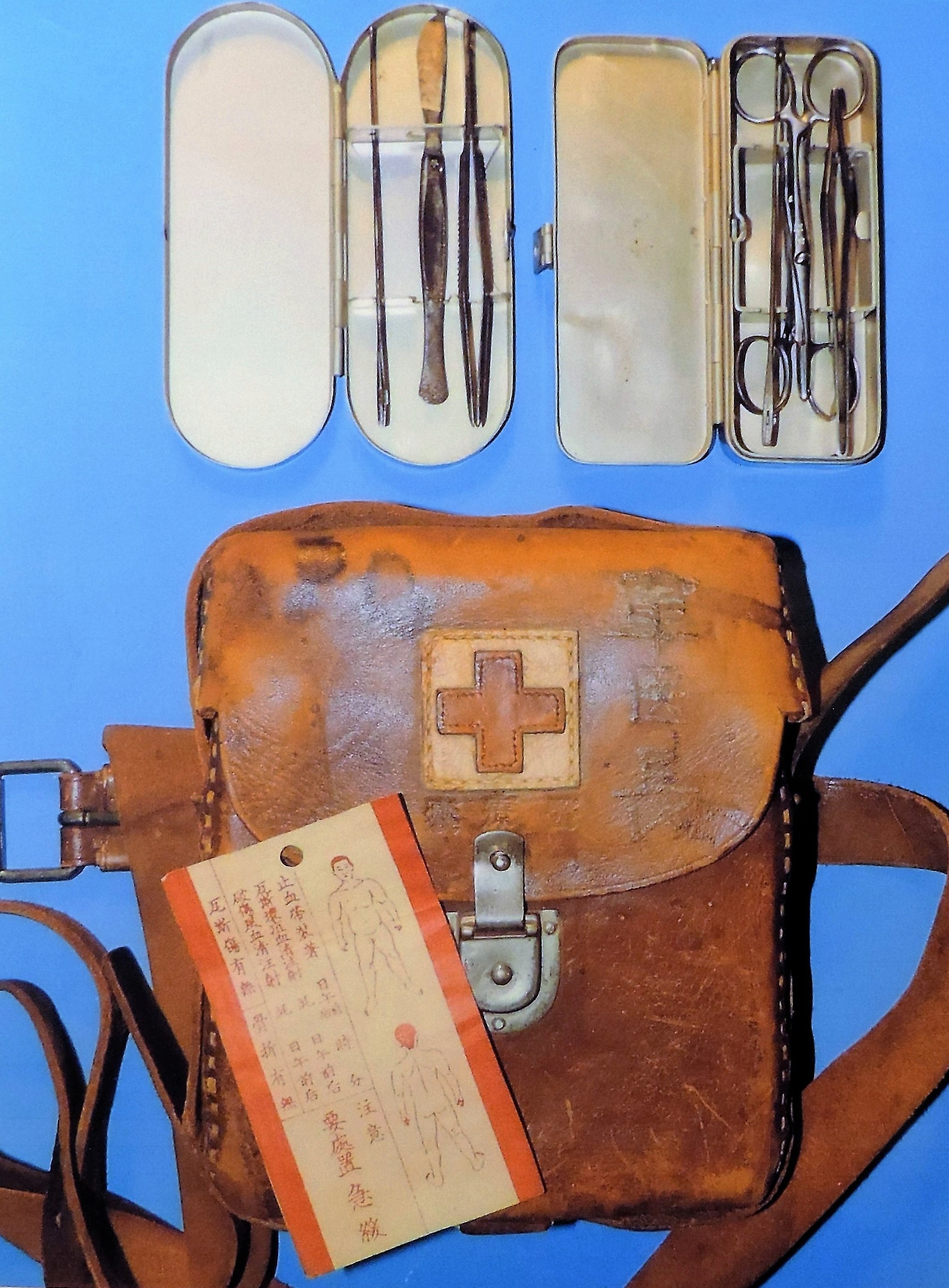
Figure 500. WWII Japanese field medical kit with contents. |
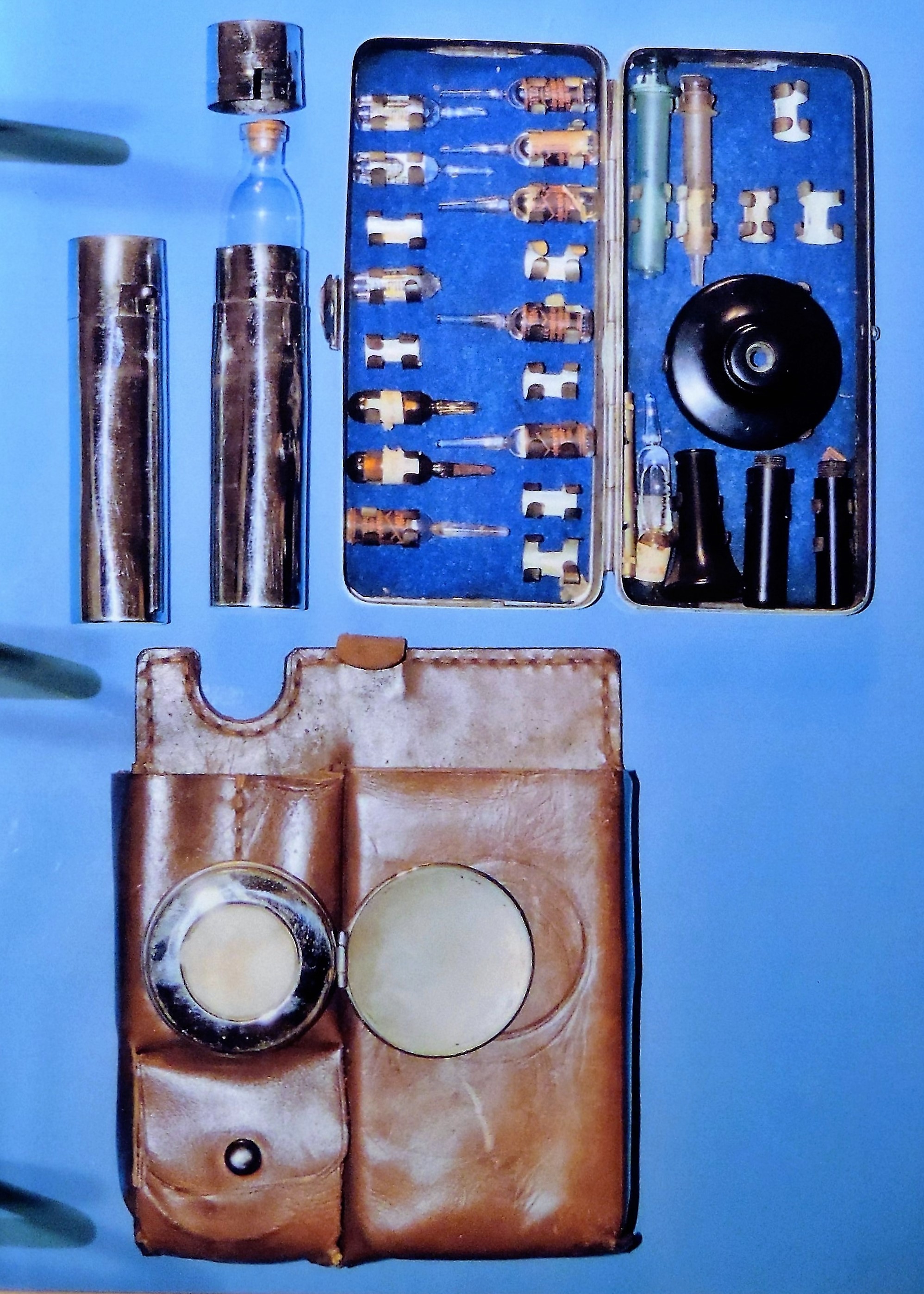
Figure 501. WWII Japanese syringe kit. |
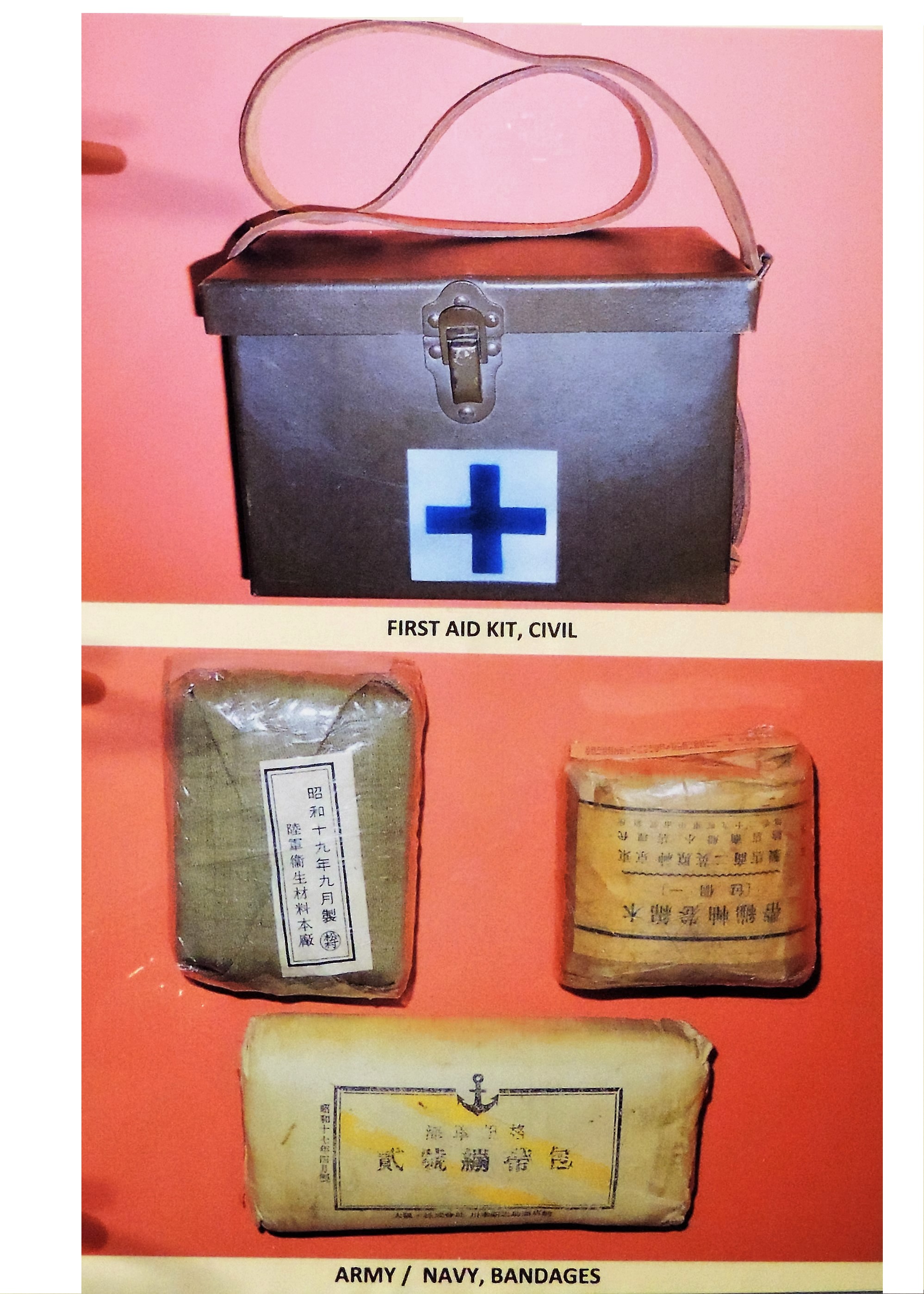
Figure 502. WWII Japanese civilian leather medical kit and miscellaneous army/navy bandages. |
| | ||
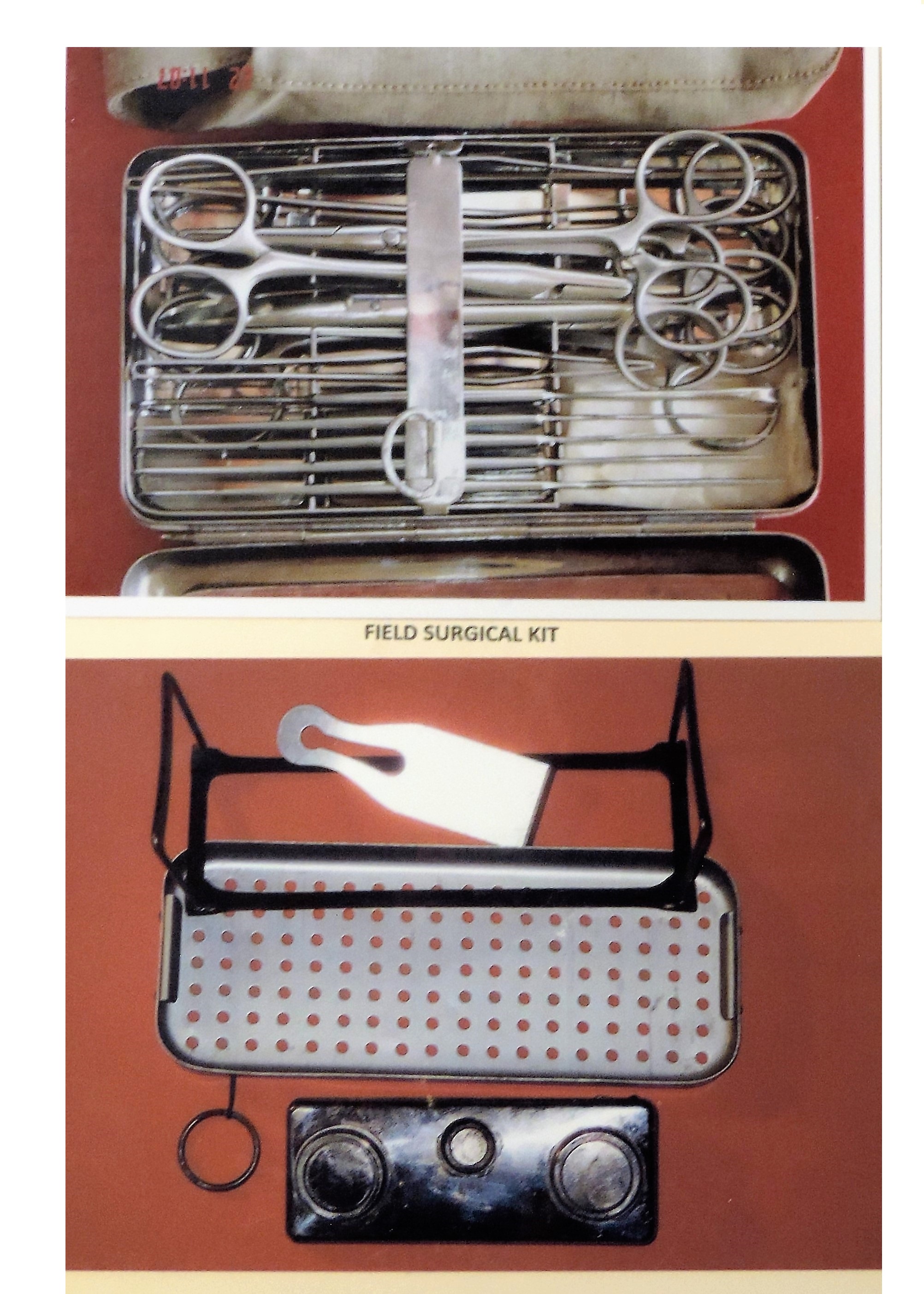
Figure 503. WWII Japanese surgical kit. |

Figure 504. WWII Japanese thermometer and miscellaneous medical bottles. |
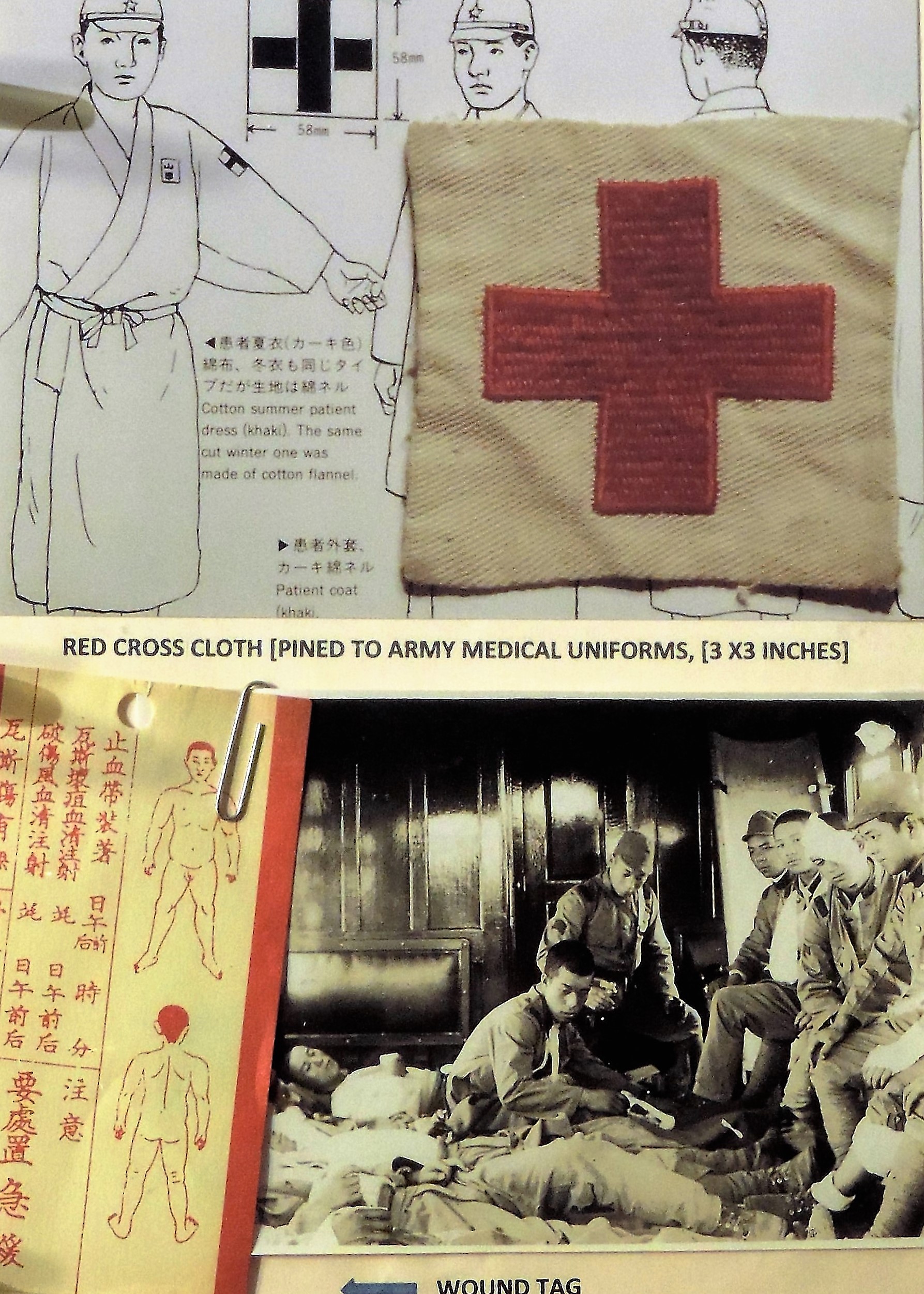
Figure 505. WWII Japanese paper wound tag. |
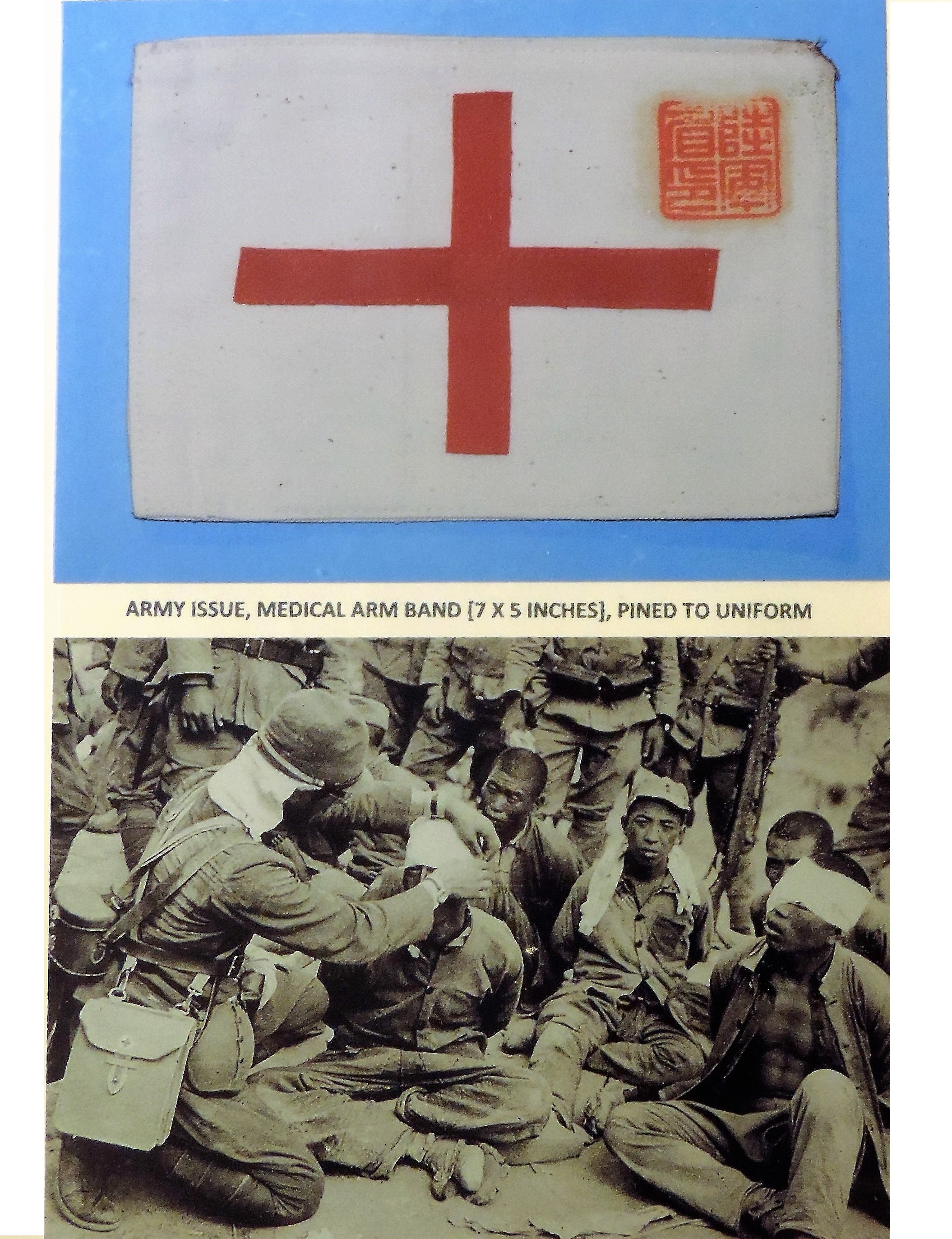
Figure 506. WWII Japanese medical armband. |
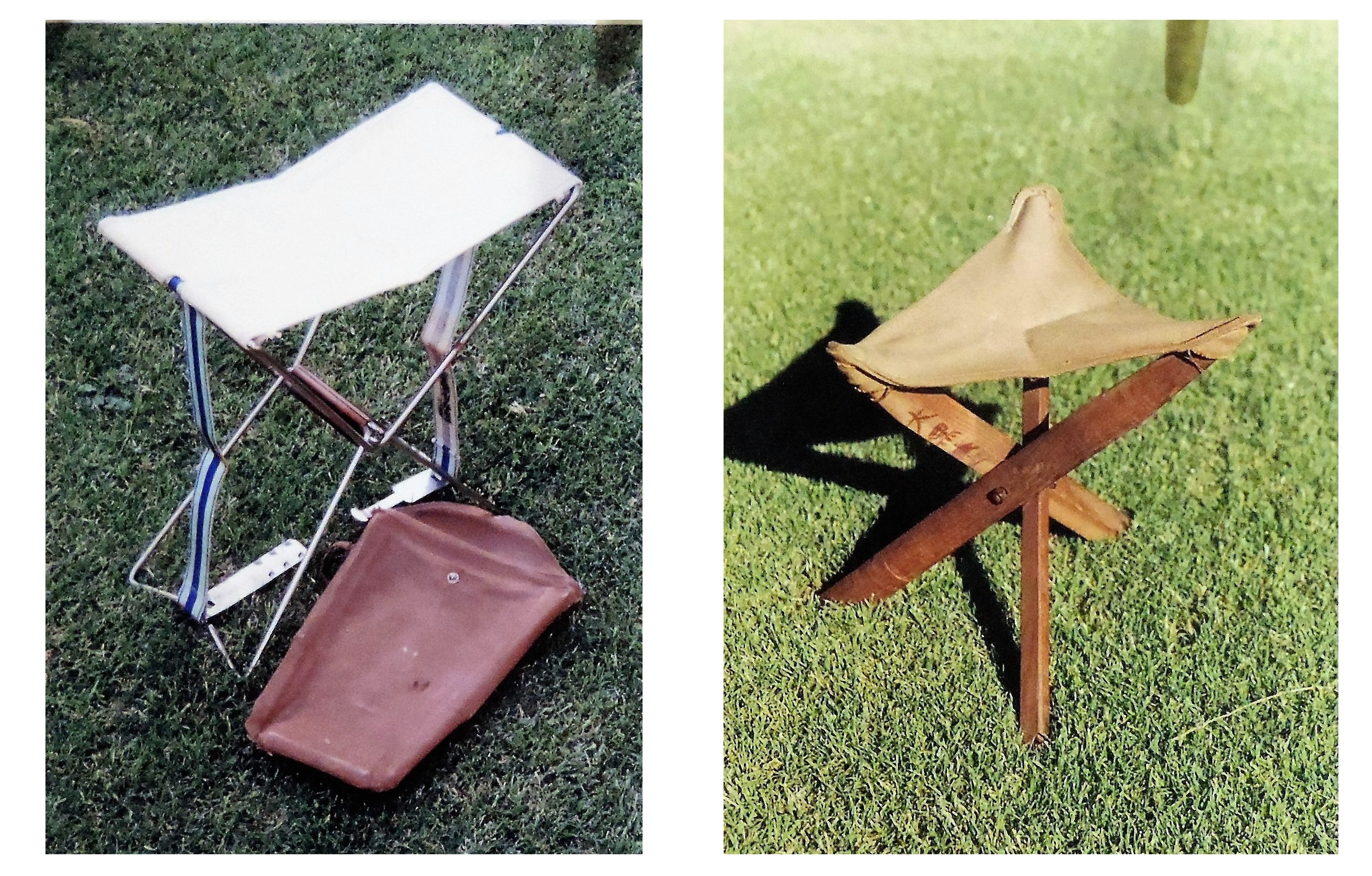
Figure 507. WWII Japanese Field medical stools. |
